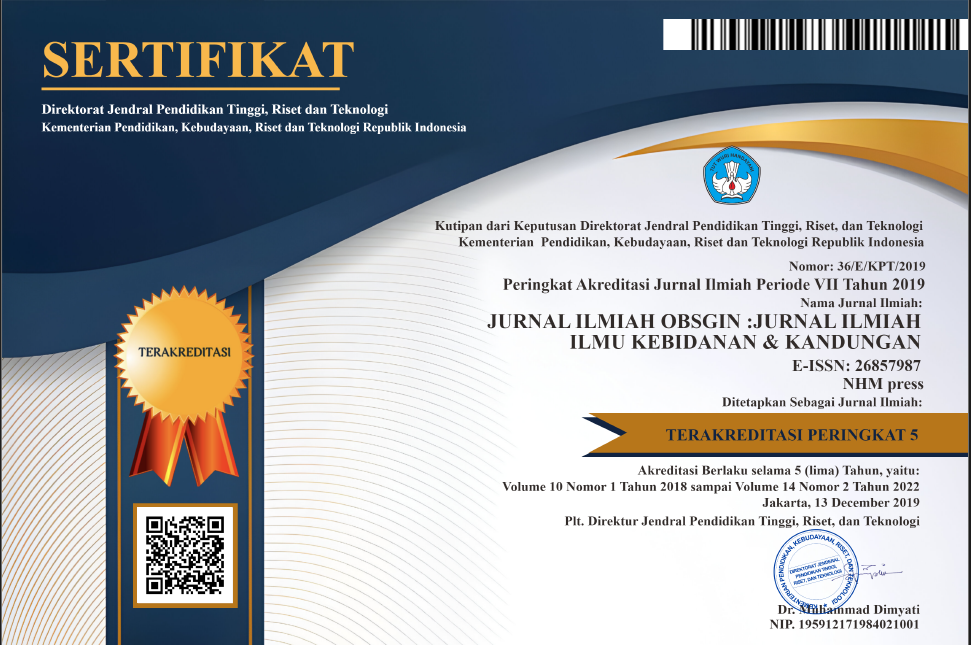RISIKO PENINGKATAN HORMON KORTISOL PADA HIPERTENSI GESTASIONAL
Abstract
Hypertension ranks the second leading cause of maternal and neonatal mortality and morbidity globally. The occurrence of hypertension is 70% due to uncomplicated gestational hypertension/preeclampsia. This study aims to analyze risk factors that can cause increase of cortisol hormone, and the relationship between cortisol and gestational hypertension. This research used the analytic observational study design with case control method. The samples (50 respondents) were selected with consecutive sampling technique. The study was conducted at Siti Fatimah, Pertiwi, Sitti Khadijah 1 Local Special Hospital for Mothers and Children in Makassar, and the Teaching Hospital Laboratory of Hasanuddin University from 2 to 30 October 2017. The samples included 20 samples of normal pregnant women and 30 samples of pregnant women with gestational hypertension (including 20 samples with single pregnancy and 10 samples with multiple pregnancy). The instruments were questionnaires for demographic data, Kessler psychological distress scale questionnaire (K10), and ELISA kit. Salivary cortisol hormone levels were examined using the ELISA method. The data were analyzed using independent t test and Mann Whitney U test to assess the comparison. Chi Square and Fisher exact tests were also used to analyze the correlation, and odds ratio was used to assess the strength of the correlation. The simple linear regression test was used to examine the causal relationship between independent and dependent variable. The results show that stress is the risk factor of cortisol hormone increase with p value = 0.000 (p <0.05); OR = 12.267; while parity and multiple pregnancy are not the risk factor of cortisol hormone increase. There is a significant correlation between the levels of cortisol hormone and gestational hypertension with p value = 0.000 (p <0.05); OR = 20,000.
References
Adisty N. I., Hutomo M. & Indramaya D. M. (2015). Kadar Kortisol Saliva Menggambarkan Kadar Kortisol Serum Pasien Dermatitis Atopik ( Salivary Cortisol Levels Representing Serum Cortisol Levels in Atopic Dermatitis Patients ). BIKKK - Berkala Ilmu Kesehatan Kulit Dan Kelamin - Periodical of Dermatology and Venereology, 27(3): 170–175.
Black J. M. & Hawks J. H. (2014). Keperawatan Medikal Bedah : Manajemen Klinis untuk Hasil yang Diharapkan, Edisi Bahasa Indonesia. (J. Mulyanto, Yudhistira, A. P. Tunggono, N. H. Setiyawan, R. Martanti, Natalia, Candrawati, Eds.) (Edisi 8). Singapura: Elsevier.
Bolten M. I. & Wurmser H. (2011). Cortisol levels in pregnancy as a psychobiological predictor for birth weight Cortisol levels in pregnancy as a psychobiological predictor for birth weight. Springer.
Boron W. F. & Boulpaep E. L. (2016). Medical physiology : a cellular and molecular approach. Philadelphia: Elsevier.
Connor T. G. O., Tang W., Gilchrist M. A., Moynihan J. A., Pressman E. K. & Blackmore, E. R. (2014). Diurnal cortisol patterns and psychiatric symptoms in pregnancy : Short-term longitudinal study. Biological Psychology, 96: 35–41.
Dc Dutta H. K. (2013). Hypertensive disorders in pregnancy. DC Dutta’s Textbook of Obstetrics, (May): 219–240.
DiPietro J. A. (2012). Maternal Stress in Pregnancy : Considerations for Fetal Development. Journal of Adolescent Health, 51(2): S3–S8.
Edwards S., Evans P., Hucklebridge F. & Clow A. (2001). Association between time of awakening and diurnal cortisol secretory activity. Psychoneuroendocrinology, 26: 613–622.
Hidayat A. (2011). Metode Penelitian Kebidanan dan Teknik Analisa Data. Jakarta: Salemba Medika.
Hogg K., Blair J. D., Mcfadden D. E., Dadelszen P. V. & Robinson W. P. (2013). Early Onset Pre-Eclampsia Is Associated with Altered DNA Methylation of Cortisol-Signalling and Steroidogenic Genes in the Placenta. Plos One, 8(5).
Kemenkes RI. (2014). Pusdatin Hipertensi. Infodatin, (Hipertensi): 1 – 7.
Kementerian Kesehatan RI. (2016). Profil Kesehatan Indonesia 2015. Jakarta: Kemeterian Kesehatan Republik Indonesia.
Leeman L., Dresang L. E. E. T., Health P. & Fontaine W. P. (2016). Hypertensive Disorders of Pregnancy. American Family Physician, 93(2).
Magee L. A., Pels A., Helewa M., Rey E. & Dadelszen P. V. (2014). Pregnancy Hypertension : An International Journal of Women’s Cardiovascular Health The classification , diagnosis and management of the hypertensive disorders of pregnancy : A revised statement from the ISSHP. Pregnancy Hypertension: An International Journal of Women’s Cardiovascular Health, 4: 97–145.
Muñoz-durango N., Fuentes C. A., Castillo A. E. & Kalergis A. M. (2016). Role of the Renin-Angiotensin-Aldosterone System beyond Blood Pressure Regulation : Molecular and Cellular Mechanisms Involved in End-Organ Damage during Arterial Hypertension. International Journal of Molecular Sciences: 1–17.
Nugteren J. J., Snijder C. A., Hofman A., Jaddoe V. W. V., Steegers E. A. P. & Burdorf A. (2012). Work-Related Maternal Risk Factors and the Risk of Pregnancy Induced Hypertension and Preeclampsia during Pregnancy . The Generation R Study. Plos One, 7(6).
Piazza J. R., Charles S. T., Stawski R. S. & Almeida D. M. (2014). Age and the association between negative affective states and diurnal cortisol. NIH Public Access, 28(1): 47–56.
Sajith M., Nimbargi V., Modi A. & Sumariya R. (2014). Incidence of pregnancy induced hypertension and prescription pattern of antihypertensive drugs in pregnancy. International Journal of Pharma Sciences and Research (IJPSR), 5(04): 163–170.
Sherwood L. (2014). Fisiologi Manusia Dari Sel ke Sistem (Edisi 8). Jakarta: EGC.
Strobino D., Werner E. & Mandal M. (2015). Literature Review : Antihypertensive Medication in Pregnancy An Update from the 2011 WHO Recommendations for Prevention and Treatment of Pre-eclampsia and Eclampsia. Jhpiego.
Syahrir A., Nurmiyati P. E. & Gasang. (2015). Profil Kesehatan Propinsi Sulawesi Selatan 2014. Makassar: Dinas Kesehatan Provinsi Sulawesi Selatan.
Velikonja U. (2008). The costs of multiple gestation pregnancies in assisted reproduction. Harvard Journal of Law & Gender, 32.
Wang C., Qiu W., Zheng Y., Li H., Li Y., Feng B., Guo Shu., Yan Li. & Cao J. (2013). Extraneuronal Monoamine Transporter Mediates the Permissive Action of Cortisol in the Guinea Pig Trachea : Possible Involvement of Tracheal Chondrocytes. Plos One, 8(10): 1–11.
World Health Organization. (2015). World Health Statistics 2015. Switzerland: WHO Press.
Yi Y., Jing Y., Gang Z. & Weiwei X. (2017). Potential risk factor of pre-eclampsia among healthy Chinese women : a retrospective case control study . Biomed Research - India, 28(3): 1183–1188.
ZRT Laboratory. (2016). Saliva and Blood Spot Cortisol. United States.











